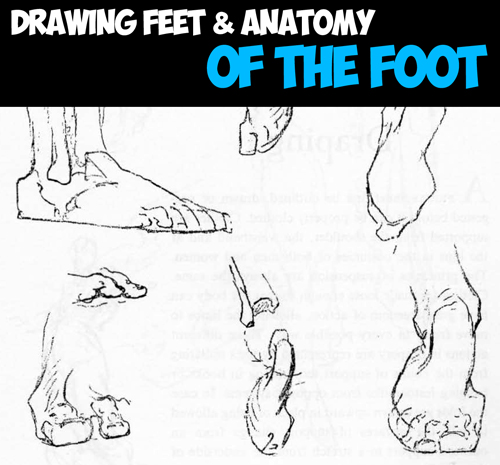

How This is a good page to reference for the next time you have to draw feet. Knowing a little bit about the anatomy and how feet can (and should) move is very helpful when you are a successful artist. There are also many reference pictures here that you may want to reference later. You can find more from this book on Amazon : from Bridgman’s Constructive Anatomy
You Might Like Our Other Hand Tutorials
As the little finger side is the heel side of the hand, so the outside of the foot is the heel side. It is level upon the ground, consistent with the heel; it is lower than within even the external lower leg bone is lower-and it is shorter. Within, just as raised by the more prominent force of the immense toe and the tendons of all the toes, is higher. To the front of the lower leg is the handle that relates with the base of the thumb. Inverse it, all things considered, is a comparative handle relating with the base of the little finger.
[ad#draw]
In the foot this symmetry is adjusted to the capacity of weight-bearing and has formed into a great arrangement of curves. The five curves of the foot meet on the heel; the toes being flying supports to them. The chunks of the foot shape a transverse curve. The inward curves of the foot are progressively higher, shaping portion of a transverse curve whose culmination is in the inverse foot. Opening step by step toward the lower leg, this angling development at last comes full circle in the two segments of the leg and the curve between; wherefore the leg is put some what to within the focal line of the foot.
In all positions, the foot tends to keep itself level with the ground, the curves of the foot evolving as needs be. In real life, the foot comes nearly into straight line with the leg, however when settling upon the ground, the external or heel side strikes first and the entire foot settles toward within.
Turning the foot internal toward the body is called adduction. Kidnapping implies dismissing. Kidnapping and adduction are controlled by the tendons that go round the internal and external lower legs. The tendons that go round the external lower leg bone draw the foot in an outward course. The tendons that pass around the internal lower leg bone turn the foot in.
The foot is additionally fit for turning and raising its internal outskirt. The muscle that causes this development goes from the external to the internal side of the leg. The tendon ignores the curve of the foot to the base of the metatarsal of the immense toe and is known as the tibialis anticus.
1 The extensors as they go under the annular ligament.
2 Tendons of both the long and short peroneals go round the external lower leg to the external side of the foot.
3 The tibialis anticus goes before the inward lower leg to be embedded into the base of the immense toe.
Toes are set on the highest point of the foot and slip descending by steps tending to keep level on the ground. The little toe is an exemption. The enormous toe, and also the little toe, has however two stages down. Alternate toes have three ventures to achieve the ground.
The mechanical invention used to move the toes, is an opening in one tendon to let another tendon go through it. A long tendon in the foot twists the to start with joint of the toe and goes through the short tendon which twists the second joint.
The foot has quality to bolster the heaviness of the body. It likewise has adaptability, flexibility and excellence of structure. Its development is the jealousy of the span manufacturers. The course of action of its tendons and ligaments as they tie, go round and through openings is associated with the belt, straps and ropes of the machine.
The curve of the foot is bent from heel to toe. The curve plays uninhibitedly between two bones, the inward and external lower leg. From the two finishes of this curve at its base, a solid flexible ligament amplifies that sinks or ascends as the
weight of the body bears upon the curve. The foot is likewise curved from side to side and in addition forward, crosswise over and on a level plane. The bones of the foot are wedged together and bound by ligaments. The leg bones lay on the curve where it expresses with the astragalus, the key-bone or cornerstone of the curve.
This cornerstone is not altered as in brick work, but rather moves openly between the inward also, external condyle. The heel is on the outside of the foot. The wad of the huge toe is within, giving it the revolving and transverse development as of now said.
And here are some feet and leg drawing reference images from Peck’s Atlas of Human Anatomy
And Here are Some Reference Pictures from Pogany’s Art of Drawing
You Might Like Our Other Hand Tutorials
Technorati Tags: feet, foot, human foot, how to draw feet, how to draw a foot, drawing feet, drawing the foot, anatomy of the foot
Today, I'll show you how to draw a cartoon girl pointing at herself with step-by-step…
Today, I'll show you how to draw a crying cute little cartoon guy who is…
Today, I'll show you how to draw an adorably super-cute cartoon owl on a witch's…
Today I will show you how to draw a super cute baby-version of Winnie The…
Today I'll show you how to draw the famous Pusheen cat from social media, such…
Today I'll show you how to draw this super cute chibi version of Deadpool from…